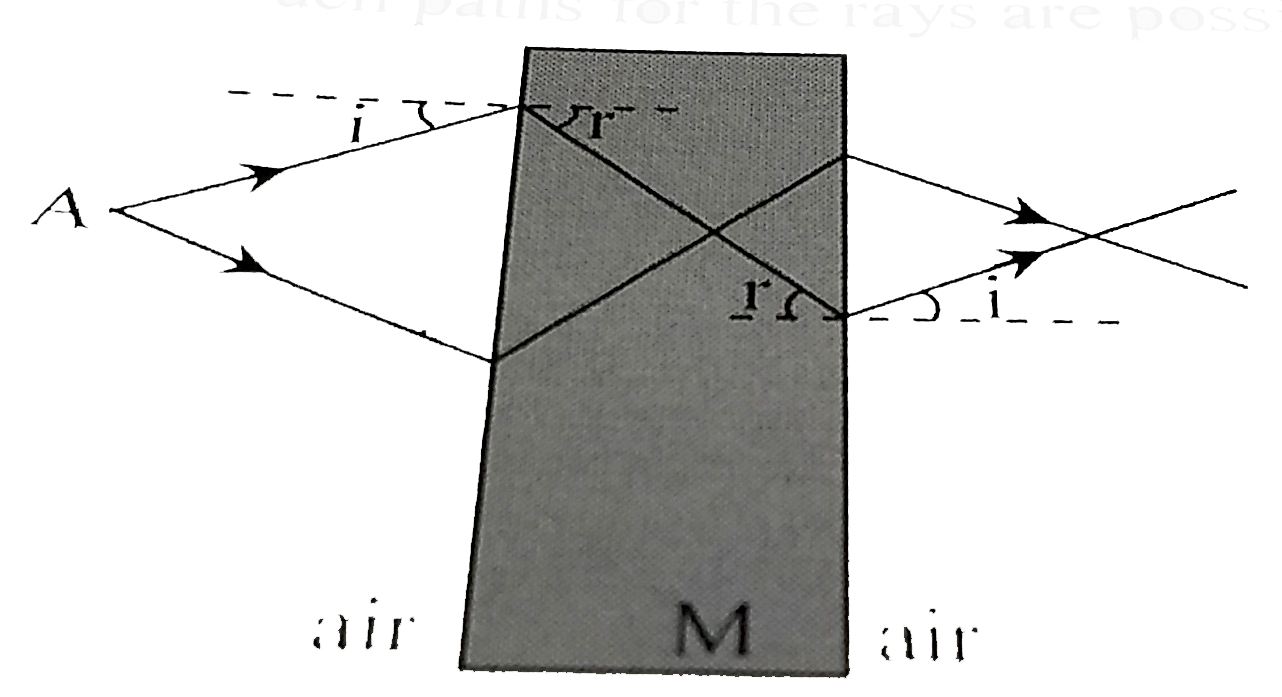Electromagnetic waves emanating from a point A (in air) are incident on a rectangular block of material M and emerge from the other side as shown. The angles i and r are angles of incidence and refraction when the wave travels from air to the medium. Such paths for the rays are possible

If the material has a refractive index very nearly equal to zero
Only with gamma rays with a wavelength smaller than atomic nuclei of the material
If the material has a refractive index less than zero
If the material has a refractive index less than zero
The correct Answer is:C
It is possible for negative μ only and materials are known as meta materials.
Topper's Solved these Questions
- RAY OPTICSBook:ERRORLESSChapter:RAY OPTICSExercise:NCERT BASED QUESTIONS ( Total internal reflection )
Explore 26 Videos
- RAY OPTICSBook:ERRORLESSChapter:RAY OPTICSExercise:NCERT BASED QUESTIONS ( Refraction at Curved surface )
Explore 61 Videos
- RAY OPTICSBook:ERRORLESSChapter:RAY OPTICSExercise:NCERT BASED QUESTIONS ( SPHERICAL MIRROR )
Explore 23 Videos
- MAGNETISMBook:ERRORLESSChapter:MAGNETISMExercise:Assertion and Reason
Explore 22 Videos
- WAVE OPTICS AND ELECTROMAGNETIC THEORYBook:ERRORLESSChapter:WAVE OPTICS AND ELECTROMAGNETIC THEORYExercise:ASSERTION & REASON
Explore 27 Videos
Similar Questions
A ray of light travelling inside a rectangular glass block of refractive index√2is incident on the glass-air surface at an angle of incidence of 45∘. The refractive index of air is one. Under these conditions the ray will
View SolutionThe angle of refraction is always greater than the angle of incidence for a ray of light travelling from optically denser medium to a rarer medium.
View Solution
Knowledge Check
A ray of light travelling inside a rectangular glass of block of refractive indx ×√2 is incident on the glass air surface at an angle of incidence of 45∘ . the refractive index of air is 1 . The ray will
Aemerge into air without any deviationBbe reflected back in to glassCbe absorbedDemerge in to air with an angle of refraction equal to 90∘A ray of light travelling inside a rectangular glass block of refractive index √2 is incident on the glass–air surface at an angle of incidence of 45∘. The refractive index of air is 1. Under these conditions the ray
AWill emerge into the air without any deviationBWill be reflected back into the glassCWill be absorbedDWill emerge into the air with an angle of refraction equal to 90∘A ray of light travelling from air to glass is deviated by an angle of 24∘. If the reflected and refracted rays are at right angles then the angles of incidence is
A48∘B57∘C28∘D24∘
A ray of light travelling inside a rectangular galss block of refractive index √2 is incident glass-air suface at an angle of incidence of 45∘. The refractive index of air is one. Under these conditions, the ray
View SolutionA ray of light is incident at an angle of 60∘ on one face of a 30∘ prism . The emergent ray from the prism makes an angle of 30∘ with the incident ray. The angle of emergence and refractive index of the material of the prism are-
View SolutionA ray of light passes from vacuum into a medium of refractive index n . If the angle of incidence is twice the angle of refraction , then the relation between the angle of incidence and the refractive index is
View SolutionA ray of light passes from vaccum into a medium of refractive index n. If the angle of incidence is twice the angle of refraction, then the angle of incidence is
View SolutionA ray of light passes from vaccume into a medium of refractive index n. if the angle of incidence is twice the angle of refraction, then the angle of incidence is
View Solution